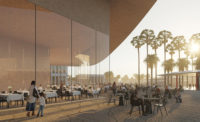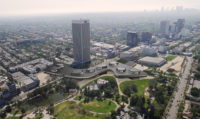LACMA Defends Its New Building by Peter Zumthor

Exterior view west toward the Resnick Pavilion, rendering of David Geffen Galleries at LACMA, courtesy of Atelier Peter Zumthor & Partner/The Boundary







Architects & Firms
Though the long-planned building for the Los Angeles County Museum of Art (LACMA), designed by Pritzker Prize–laureate Peter Zumthor, received the unanimous approval of the L.A. County Board of Supervisors last year, it has been an ongoing target of withering criticism, from ad hoc groups and the Los Angeles Times art critic, Christopher Knight, who received a Pulitzer Prize this year for his dissection of the museum’s plans. The proposed new museum is an amoeba-shaped concrete form that will bridge Wilshire Boulevard from LACMA’s current site to what was a parking lot opposite, with all the new galleries flowing together on one floor. Functions such as education, retail, and restaurants will be housed in the seven pavilions holding up the floating gallery space nearly 30 feet in the air.

The Zumthor museum replaces four structures from the 1960s and the ‘80s, by William Pereira and Associates and Hardy Holzman Pfeiffer. They were works of architecture that Angelenos loved to hate, yet when the wrecking ball began razing them last spring, the Citizens Brigade to Save LACMA sprang into action, and mounted a competition for an alternative to Zumthor’s design.
Besides objecting to the boulevard-leaping scheme, critics have been scratching their heads in noting that the new museum is smaller than first advertised, and they have expressed concern that it cannot adequately display LACMA’s permanent collections. The new scheme, initially said to total 387,500 square feet of space, is now down to 347,500 square feet, according to the most recent Environmental Impact Report (EIR), says a spokesperson. Critics also wonder whether the $650 million price tag will soar much higher.

Now LACMA is counter-punching by releasing new renderings and a fact sheet, stating the future museum will contain 110,000 square feet of galleries (an earlier EIR noted 170,000 square feet for exhibitions), to be dedicated to the permanent collection, installed on a rotating basis. The two newish buildings by Renzo Piano on the west side of the LACMA campus—the Broad building and the Resnick Pavilion, with a combined total of 100,000 square feet of galleries—will be used for temporary exhibitions. LACMA’s offices are now in several floors of rental space nearby, where they will remain.

Museum director Michael Govan maintains the construction “is on time and on budget,” with the opening planned for 2024. The press release accounts for $100 million added to the $650 million fundraising goal, for “ancillary expenses, such as financing and campaign costs.” It also states there will be newly developed outdoor public space of 3.5 acres, including sculpture gardens. Govan also argues that the original structures (which contained a total of 120,000 square feet of galleries) would have required hundreds of millions of dollars to properly upgrade. And as there is no gained exhibition space—in fact, a loss of 10,000 square feet—he points to ambitious future plans to open LACMA satellites in underserved parts of the city; the first will be a ground-up new building on a site in south L.A.
LACMA is Zumthor’s first American project, and it is his unbridled expression of L.A. culture (the Swiss architect taught at Sci-Arc in the 1980s) as a giant, undulating hovercraft poised above endless streams of traffic. When, in developing the design, he left behind the conventional grid, he has said, “that was a moment of liberation.” And he ran with it.








